Tegasac Oak Park recently held an open day to celebrate the 60th anniversary since the opening of its research centre. The aim of the event was to show the public how machines have evolved over this key period of mechanisation adoption. This unique display of tillage machinery of the 1960s was made possible by the generous help of all who offered their machines – in particular, Tom Pender of the Irish Vintage association, who located many of the machines.
In each case, the machines from the 1960s were shown alongside a modern machine for comparison, with key specification information provided on individual boards.
Perhaps the most surprising aspect of the change in machines over 60 years, is the relative lack of change in the operating principals of the machines. A combine of today has the same functional components at its core, as those in the 1950s and 1960s.
But what has changed is the size, sophistication, use of control systems and particularly weight, leading to machines with the capacity to work at three to seven times the workrate of those in the past. The main benefits this brings include timeliness, quality of work and, especially, labour efficiency.
But one of the key disadvantages has been the increase in machine weight which, if not catered for, can threaten the soil structure.
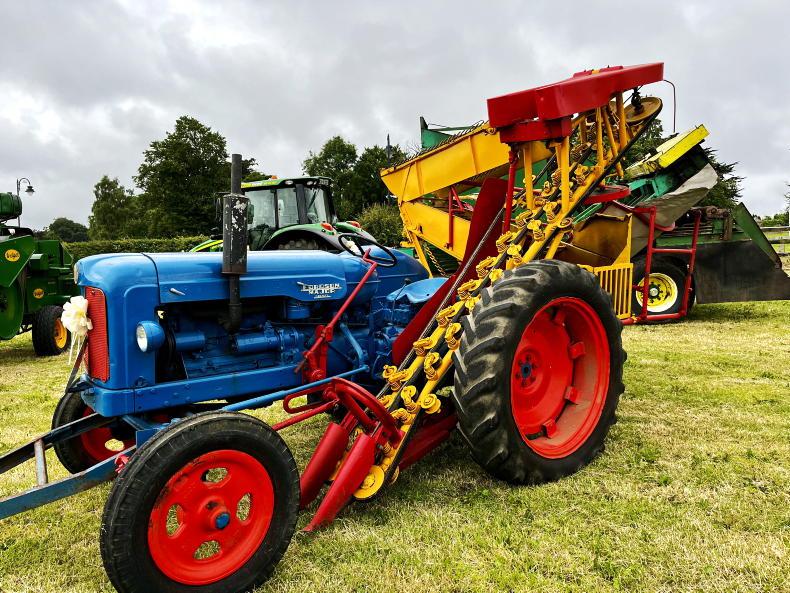
The Armer Mk V beet harvester, designed and built in Co Carlow was one of the most unique machines there on the day.
Armer Beet harvester
The most unique machine on display was the Armer Mk V beet harvester. Designed and produced in Carlow, according to former Armer designer Tom Clowry, this model was instrumental in mechanising the beet harvest. The lifting rail was placed between the driver and the left side, rear tractor wheel, requiring significant tractor modification. The tractor steering guided the rail on the row. The basic belt lifting mechanism, which was ideally suited to harvesting in stoney conditions, remained intact through the 1990s in trailed single and multi-row versions. The immaculately restored Mk V was provide by the family of the late Pa Brennan of Crossneen.
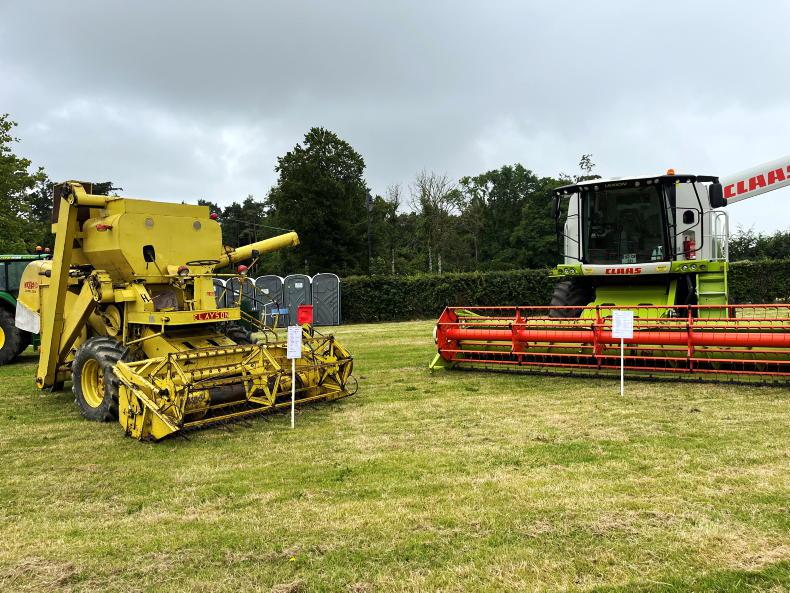
A 1960s Clayson M103 combine capable of 40ac daily, was shown alongside a modern Claas Lexion 630, capable of between three and four times the output.
Clayson combine
The Clayson M103 was a popular model in the 1960s, when bulk grain tanks were less common than bagging chutes on Irish machines. This original machine, which cuts 40 acres of cereals each year, was supplied by Robert Mitchell. While almost dwarfed by the size (14.3t vs 5t) and power (354hp vs 80hp) of the Claas Lexion 630 standing alongside, the relative grain separation and cleaning areas of the Clayson were not all that small. With the Lexion capable of three to four times the output of M103, it illustrates the ability of modern designs to get the most out of the basic threshing, separation and cleaning components.
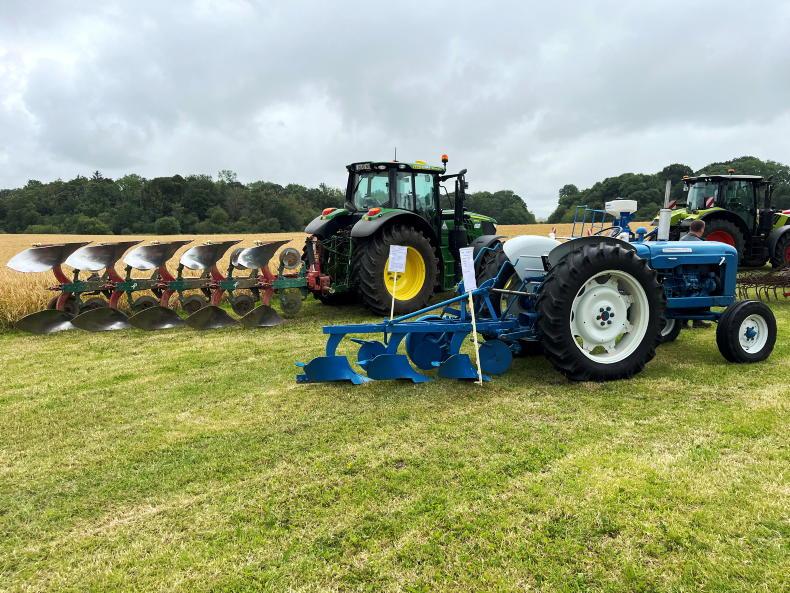
This 1963 54hp Fordson Major was matched to a three-furrow, 12” (30cm) Ransomes one-way plough.
Fordson Major and Ransomes plough
Illustrating the change in primary cultivation, the last version of the Fordson Major, the 1963 New Performance Major with full draft control and 54hp was matched to a threee-furrow, 12” (30cm) Ransomes one-way plough. This six-speed 2.4t machine was compared with a John Deere 6155M, which has 20 forward gears (four power shifts), 155hp and weighs 7.8t, and was matched to a five-furrow vari-width (30-50cm) Kverneland ES reversible plough. The modern ploughing outfit would probably have a workrate of three to five times that of the 1960s model.
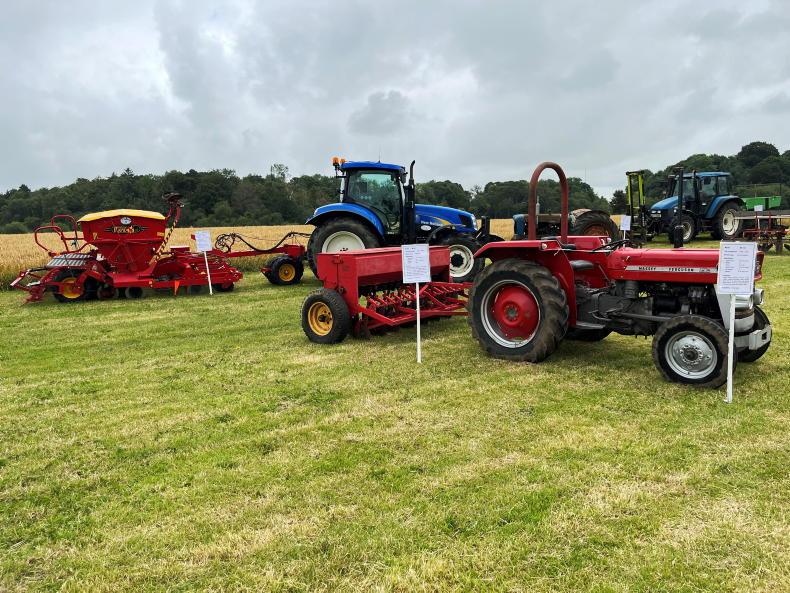
This Massey Ferguson 135 was paired with a Massey Ferguson 34 drill and shown alongside a modern Vaderstad drill and New Holland T6050.
MF 135 and MF 34 drill
A pairing that emphasized the change in size and weight since the 1960s was the extremely compact MF 135 (launched in 1964) and an MF 34 drill. This drill provided by Douglas Murray was lighter than the hugely popular MF 30, which was to follow in the 1970s, being an easy pull for the six-speed 45hp 1.5t MF 135. While only suitable for fully cultivated seedbeds, this light outfit would probably be capable of sowing at about half the workrate of the much heavier Vaderstad drill 2.6t and new 125hp Holland T6050 ( 5t) seen in the background.

A1950s Welger AP15 square baler fitted with a 'donkey' engine, alongside a modern Massey Ferguson RB 3130F round baler.
Welger baler
This immaculately restored, green Welger AP15 baler from the 1950s, complete with independent ‘donkey’ engine providing the drive, was shown behind an equally pristine David Brown 990 Implematic of the 1960s. Despite the baler’s age, all of the elements of the small square baler design that persist to the current day were present. The baler was supplied by Eddie Hickey, who fully restored this model, which had been purchased by his father in the 1960s. It is an immensely strong construction. The modern round baler sitting alongside, the Massey Ferguson 3130F, would clear in two hours what older square balers might do in a day.

Showing a major contrast in size difference was a Bunning Lowlander 4-105 and a 1960s Massey Ferguson 19 muckspreader.
Muckspreaders
Illustrating almost perfectly that machine concepts have remained the same, but size has expanded tremendously, the contrast between today’s Bunning Lowlander 4-105 and the early 1960s MF 19 muckspreader was stark. Both are pto-driven, moving floor spreaders with vertical (Bunning) or horizontal (MF) spreading beaters. But the Bunning weighs in at 5t empty and can carry 12t of FYM, whereas the MF spreader weighs in at less than 1t and can carry just 2t of FYM. Not too many would choose to load the Bunning by hand though. The MF spreader was provided by Wayne Wedlock.

The single-disc Massey Ferguson spreader (right) was displayed alongside a modern twin-disc Bogballe L20.
Fertiliser spreaders
Fertiliser spreaders have evolved significantly from the single-disc MF model in the foreground when compared to a modern Bogballe L20 twin-disc machine. While having four-times the hopper size, the main benefit of the modern machine is its ability to spread accurately to 24m. The earlier, single-disc spreader would need to be operated at narrow bout widths (approximately 6m) and operated in a round-and round-pattern in the field, to cope with the non-symmetrical pattern.

The autonomous Farmdroid FD20 weeder and seeder was presented alongside two Armer steerage hoes.
Guided weeders
Modern guided technology was showcased by the autonomous Farmdroid of today, which can sow and weed row crops like beet. No operator is needed, as it’s guided by accurate GPS signals. This unit is proving commercially successful, with more than 60 units sold in Europe. But the concept of precision weeding to reduce/eliminate herbicide use was also evident in the 1960s, with two Armer steerage hoes on show. These three-point-linkage machines had a second operator in the implement seat, carefully steering the weeding elements along the row, to ensure they avoided the beet plants.

A Massey Ferguson 5475 and Amazone one-pass seed drill, showing how tilling and sowing are now usually combined.
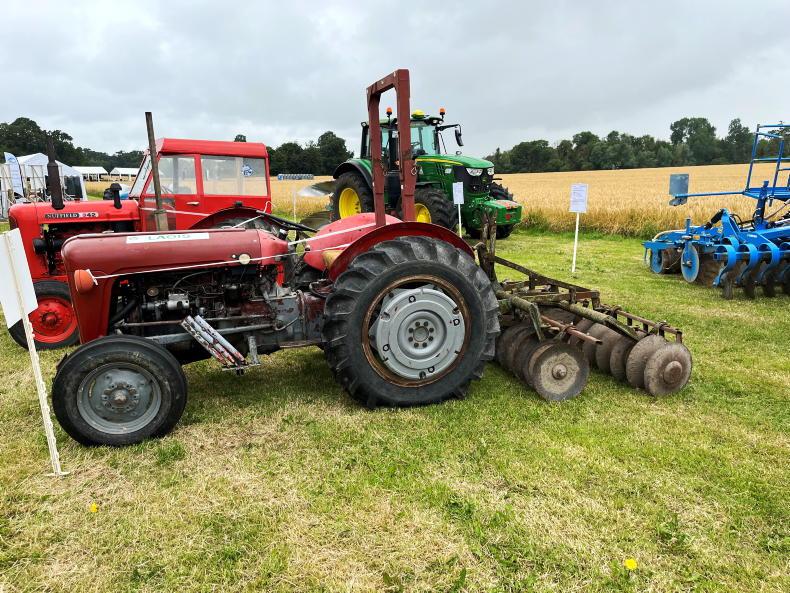
A Massey Ferguson 35 and 2.4m disc harrow.
Soil cultivation
In the early 1960s, seedbed preparation was achieved with multiple passes of either tine or disc machines, such as the four-cylinder MF 35 and 2.4m disc harrow.
While very light (total weight approx. 2t), multiple passes resulted in excessive drying out of the soil and multiple wheel passes. Today, tilling and sowing operations are usually combined in the one pass. The MF 5475 and Amazone one-pass combination(left), would have an all-up weight with front press of more than 10t.
A one pass of this machine typically replaced four runs of older tillage and sowing combinations, saving time and fuel.

A Landrover Series 2A (left) and Morris Oxford (centre) were shown alongside a modernFord Ranger pickup.
Farm cars
What cars were seen on Irish farms in the 1960s? While Landrovers like the Series 2A were popular farm workhorses in the UK, in Ireland any cars used were dual purpose and the family saloon, like the Morris Oxford provided by Ivan Mitchell, were commonly used. These cars had leisurely acceleration, were not for field use, and had a boot that was easily damaged and frequently kept shut with baling twine, but they were better on the road than the Landrovers of the time. Today, many farms have adopted 4WD pick-up types as their utility vehicles, such as the Ford Ranger. While hugely versatile, their fuel use for normal road use is quite high.
And more

This 1963 54hp Fordson Major was matched to a three-furrow, 12” (30cm) Ransomes one-way plough.
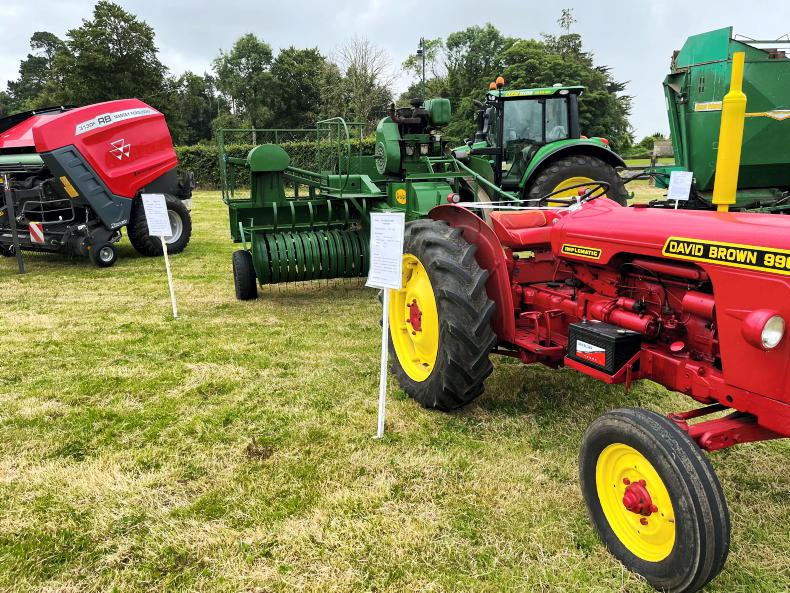
This 1950s Welger AP15 baler fitted with a 'donkey' engine was paired with a David Brown 990 Implematic of the 1960s.
Tegasac Oak Park recently held an open day to celebrate the 60th anniversary since the opening of its research centre. The aim of the event was to show the public how machines have evolved over this key period of mechanisation adoption. This unique display of tillage machinery of the 1960s was made possible by the generous help of all who offered their machines – in particular, Tom Pender of the Irish Vintage association, who located many of the machines.
In each case, the machines from the 1960s were shown alongside a modern machine for comparison, with key specification information provided on individual boards.
Perhaps the most surprising aspect of the change in machines over 60 years, is the relative lack of change in the operating principals of the machines. A combine of today has the same functional components at its core, as those in the 1950s and 1960s.
But what has changed is the size, sophistication, use of control systems and particularly weight, leading to machines with the capacity to work at three to seven times the workrate of those in the past. The main benefits this brings include timeliness, quality of work and, especially, labour efficiency.
But one of the key disadvantages has been the increase in machine weight which, if not catered for, can threaten the soil structure.

The Armer Mk V beet harvester, designed and built in Co Carlow was one of the most unique machines there on the day.
Armer Beet harvester
The most unique machine on display was the Armer Mk V beet harvester. Designed and produced in Carlow, according to former Armer designer Tom Clowry, this model was instrumental in mechanising the beet harvest. The lifting rail was placed between the driver and the left side, rear tractor wheel, requiring significant tractor modification. The tractor steering guided the rail on the row. The basic belt lifting mechanism, which was ideally suited to harvesting in stoney conditions, remained intact through the 1990s in trailed single and multi-row versions. The immaculately restored Mk V was provide by the family of the late Pa Brennan of Crossneen.

A 1960s Clayson M103 combine capable of 40ac daily, was shown alongside a modern Claas Lexion 630, capable of between three and four times the output.
Clayson combine
The Clayson M103 was a popular model in the 1960s, when bulk grain tanks were less common than bagging chutes on Irish machines. This original machine, which cuts 40 acres of cereals each year, was supplied by Robert Mitchell. While almost dwarfed by the size (14.3t vs 5t) and power (354hp vs 80hp) of the Claas Lexion 630 standing alongside, the relative grain separation and cleaning areas of the Clayson were not all that small. With the Lexion capable of three to four times the output of M103, it illustrates the ability of modern designs to get the most out of the basic threshing, separation and cleaning components.

This 1963 54hp Fordson Major was matched to a three-furrow, 12” (30cm) Ransomes one-way plough.
Fordson Major and Ransomes plough
Illustrating the change in primary cultivation, the last version of the Fordson Major, the 1963 New Performance Major with full draft control and 54hp was matched to a threee-furrow, 12” (30cm) Ransomes one-way plough. This six-speed 2.4t machine was compared with a John Deere 6155M, which has 20 forward gears (four power shifts), 155hp and weighs 7.8t, and was matched to a five-furrow vari-width (30-50cm) Kverneland ES reversible plough. The modern ploughing outfit would probably have a workrate of three to five times that of the 1960s model.

This Massey Ferguson 135 was paired with a Massey Ferguson 34 drill and shown alongside a modern Vaderstad drill and New Holland T6050.
MF 135 and MF 34 drill
A pairing that emphasized the change in size and weight since the 1960s was the extremely compact MF 135 (launched in 1964) and an MF 34 drill. This drill provided by Douglas Murray was lighter than the hugely popular MF 30, which was to follow in the 1970s, being an easy pull for the six-speed 45hp 1.5t MF 135. While only suitable for fully cultivated seedbeds, this light outfit would probably be capable of sowing at about half the workrate of the much heavier Vaderstad drill 2.6t and new 125hp Holland T6050 ( 5t) seen in the background.

A1950s Welger AP15 square baler fitted with a 'donkey' engine, alongside a modern Massey Ferguson RB 3130F round baler.
Welger baler
This immaculately restored, green Welger AP15 baler from the 1950s, complete with independent ‘donkey’ engine providing the drive, was shown behind an equally pristine David Brown 990 Implematic of the 1960s. Despite the baler’s age, all of the elements of the small square baler design that persist to the current day were present. The baler was supplied by Eddie Hickey, who fully restored this model, which had been purchased by his father in the 1960s. It is an immensely strong construction. The modern round baler sitting alongside, the Massey Ferguson 3130F, would clear in two hours what older square balers might do in a day.

Showing a major contrast in size difference was a Bunning Lowlander 4-105 and a 1960s Massey Ferguson 19 muckspreader.
Muckspreaders
Illustrating almost perfectly that machine concepts have remained the same, but size has expanded tremendously, the contrast between today’s Bunning Lowlander 4-105 and the early 1960s MF 19 muckspreader was stark. Both are pto-driven, moving floor spreaders with vertical (Bunning) or horizontal (MF) spreading beaters. But the Bunning weighs in at 5t empty and can carry 12t of FYM, whereas the MF spreader weighs in at less than 1t and can carry just 2t of FYM. Not too many would choose to load the Bunning by hand though. The MF spreader was provided by Wayne Wedlock.

The single-disc Massey Ferguson spreader (right) was displayed alongside a modern twin-disc Bogballe L20.
Fertiliser spreaders
Fertiliser spreaders have evolved significantly from the single-disc MF model in the foreground when compared to a modern Bogballe L20 twin-disc machine. While having four-times the hopper size, the main benefit of the modern machine is its ability to spread accurately to 24m. The earlier, single-disc spreader would need to be operated at narrow bout widths (approximately 6m) and operated in a round-and round-pattern in the field, to cope with the non-symmetrical pattern.

The autonomous Farmdroid FD20 weeder and seeder was presented alongside two Armer steerage hoes.
Guided weeders
Modern guided technology was showcased by the autonomous Farmdroid of today, which can sow and weed row crops like beet. No operator is needed, as it’s guided by accurate GPS signals. This unit is proving commercially successful, with more than 60 units sold in Europe. But the concept of precision weeding to reduce/eliminate herbicide use was also evident in the 1960s, with two Armer steerage hoes on show. These three-point-linkage machines had a second operator in the implement seat, carefully steering the weeding elements along the row, to ensure they avoided the beet plants.

A Massey Ferguson 5475 and Amazone one-pass seed drill, showing how tilling and sowing are now usually combined.

A Massey Ferguson 35 and 2.4m disc harrow.
Soil cultivation
In the early 1960s, seedbed preparation was achieved with multiple passes of either tine or disc machines, such as the four-cylinder MF 35 and 2.4m disc harrow.
While very light (total weight approx. 2t), multiple passes resulted in excessive drying out of the soil and multiple wheel passes. Today, tilling and sowing operations are usually combined in the one pass. The MF 5475 and Amazone one-pass combination(left), would have an all-up weight with front press of more than 10t.
A one pass of this machine typically replaced four runs of older tillage and sowing combinations, saving time and fuel.

A Landrover Series 2A (left) and Morris Oxford (centre) were shown alongside a modernFord Ranger pickup.
Farm cars
What cars were seen on Irish farms in the 1960s? While Landrovers like the Series 2A were popular farm workhorses in the UK, in Ireland any cars used were dual purpose and the family saloon, like the Morris Oxford provided by Ivan Mitchell, were commonly used. These cars had leisurely acceleration, were not for field use, and had a boot that was easily damaged and frequently kept shut with baling twine, but they were better on the road than the Landrovers of the time. Today, many farms have adopted 4WD pick-up types as their utility vehicles, such as the Ford Ranger. While hugely versatile, their fuel use for normal road use is quite high.
And more

This 1963 54hp Fordson Major was matched to a three-furrow, 12” (30cm) Ransomes one-way plough.

This 1950s Welger AP15 baler fitted with a 'donkey' engine was paired with a David Brown 990 Implematic of the 1960s.



















 This is a subscriber-only article
This is a subscriber-only article








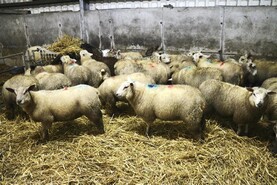

SHARING OPTIONS: